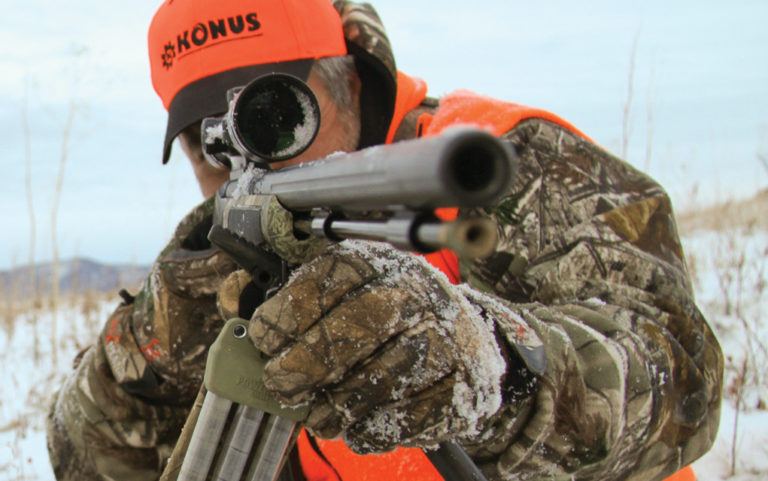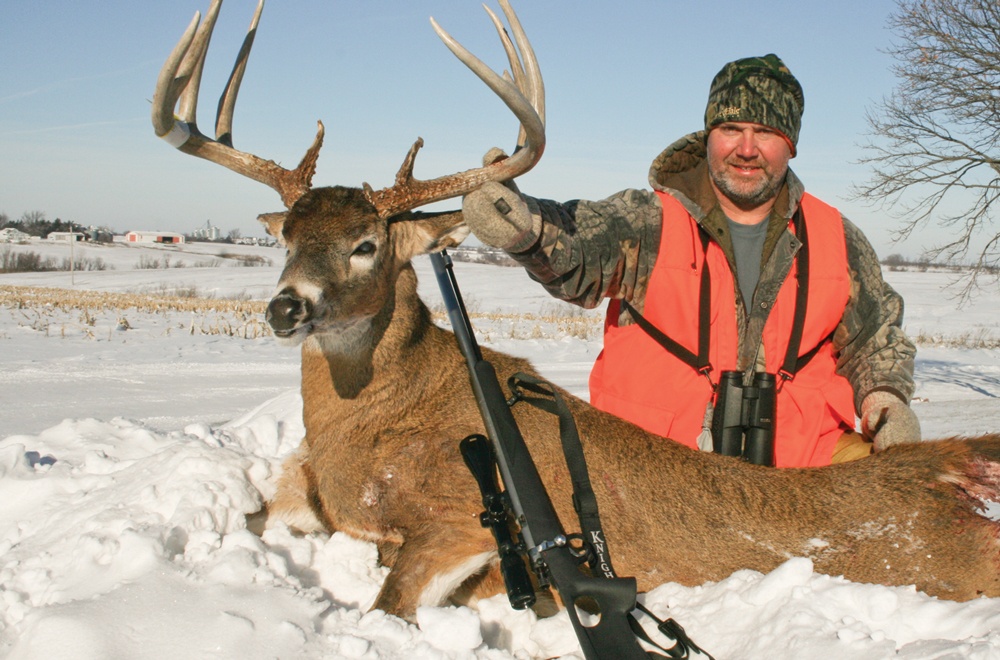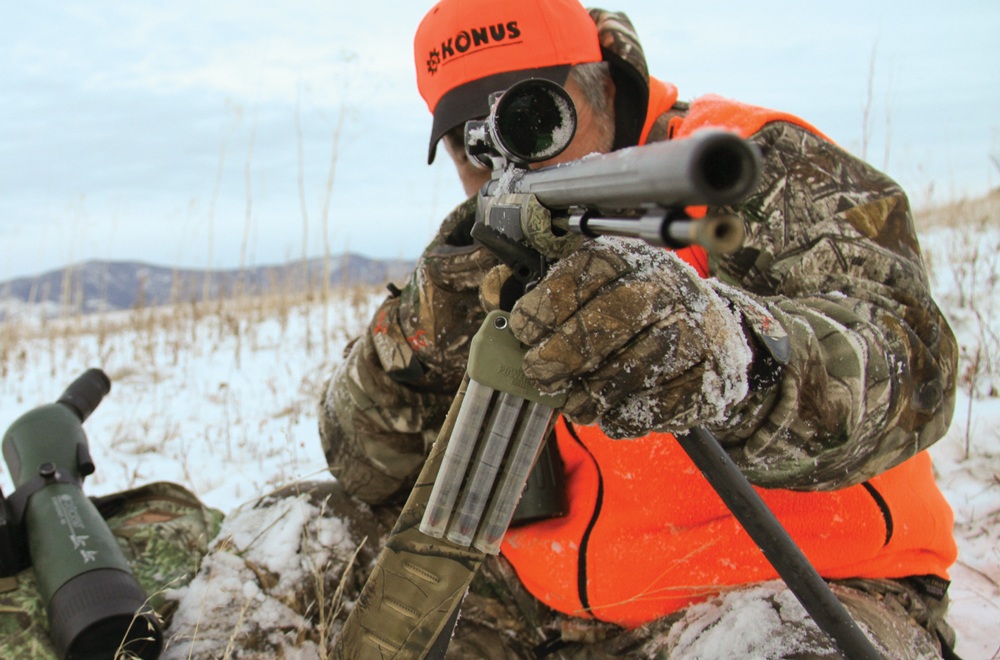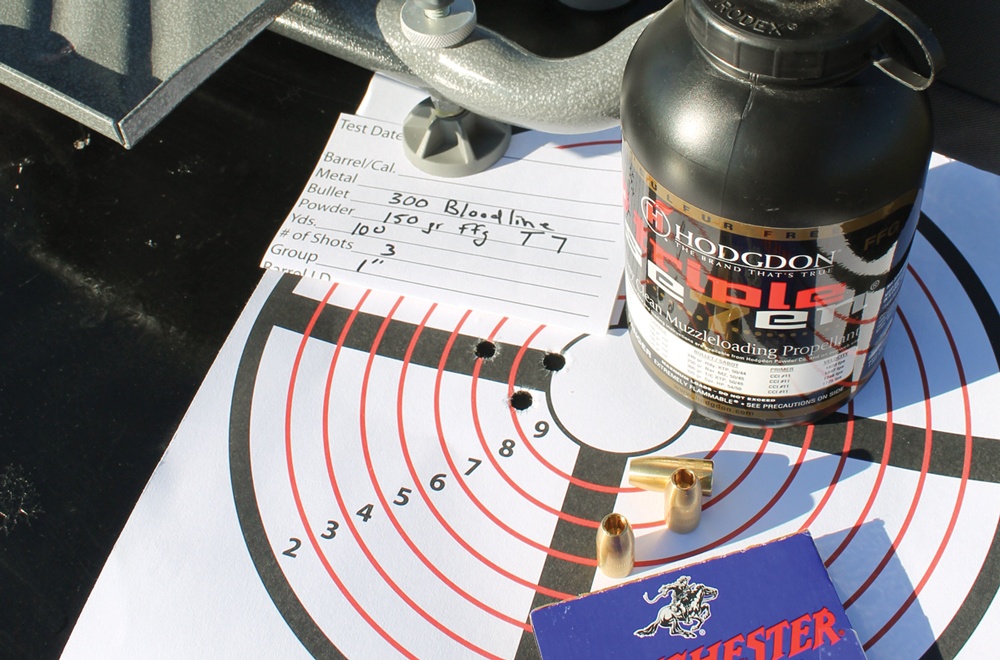
How close have we come to centerfire accuracy with today’s inline muzzleloaders? Close.
The elements of a precision modern muzzleloader:
- Every muzzleloader is different — barrel tolerances, breech plug, bullet, sabot, etc.
- Because of this not all guns shoot the same groups with the same load.
- Almost any production muzzleloader has a 1:28 twist and a barrel of 22-26 inches long.
- The 209 shotgun primer is the standard ignition source today.
- Learn your gun's accuracy potential by swabbing the bore between every shot.
- Finding the best load for your muzzleloader often takes more than a day.
Christmas of 1987 was like many before it: We opened gifts, loaded the vehicles and headed to my grandparents’ for two weeks of hunting. The pheasant population was on the decline in southern Iowa, so I found myself riding with my uncle and cousin looking for deer with traditional muzzleloaders.

After a couple of days and several shots, they had to do the dreaded cleaning routine. In the mudroom of their house, they brought in a 5-gallon bucket with hot, soapy water and started scrubbing. I was accustomed to completely tearing down my Remington 1100 every weekend to clean it, but this was ridiculous.
I told my uncle that I really enjoyed tagging along, but I wasn’t sure about this cleaning deal and hunting without a scope. “Don’t buy one of these damn things,” he said. “There’s a guy in Lancaster, Missouri, who makes one that’s easy to clean, you can mount a scope and they claim it’ll shoot as good as a rifle.” And at the end of my 2-week vacation I was the proud owner of a Knight MK-85.
Don’t scoff: That gun changed my life. I graduated from college and got a job working for Knight Rifles. During the course of more than 20 years, I held a variety of jobs for Knight, and they all involved test-shooting guns … every inline muzzleloader currently being manufactured. I spent hours with the competitors’ rifles — shooting, cleaning and picking them apart.
I was also fortunate to shoot at the National Muzzleloading Rifle Association Manufacturers Match for 3 consecutive years. I learned a lot shooting against the best of the best about doping the wind, fouling the barrel and cleaning during a timed match. We had to use guns that were available for anyone to purchase, scopes couldn’t exceed 10x, and we could use black powder or black powder substitute. One glaring fact: no one ever won shooting pellets. Think about that.
Not Your Uncle’s Smokepole
I honestly believe that, today, all the major muzzleloader manufacturers make good guns for hunting deer-sized animals. Once you hit $400, all are pretty even in accuracy. You may like a specific brand or style, but they’re pretty even — if you put in some work to make them perform.
Every muzzleloader is slightly different due to tolerances of barrel, breech plug, bullet, sabot, etc. Crazy as it sounds, there are no governing rules that say what a .50-caliber muzzleloading barrel dimensions must measure. There are rules for centerfire rifles, but nothing for muzzleloaders. One company can have a .50-caliber barrel that measures .500-inch, another can measure .502-inch or even .498-inch.

Because of things like this, not all guns shoot the same groups with the same loads. You must try multiple bullets, powder charges and primers to discover the perfect combination for your particular rifle.
Building A Shooter
Optics: Muzzleloaders are hard on scopes, and I’ve found that scopes costing less than $200 usually won’t last long. I’ve also destroyed scopes that cost more than $1,000. I tried many brands and models, and the best fit for a hunting muzzleloader is the Bushnell Elite series. I also have a couple Weaver Grand Slam scopes I like.
Bullets: Nearly every production muzzleloader barrel has a 1:28 rate of twist, and most are 22-26 inches long. This twist rate will stabilize bullets between 250 and 300 grains when shot at 1,600 to 2,100 fps.
I’ve killed more than 300 critters in 17 states, four Canadian provinces and Namibia with muzzleloaders, and I used anything from a patched round ball to 530-grain bore-sized conical bullets. All of those options killed the game, but I’m a believer in Murphy’s Law, so I prefer bullets that will perform in the worst-case scenario.
Any bullet will kill a deer standing broadside in the open at 50 yards on a calm day. But what happens at 200 yards with a 10-mph crosswind and you don’t account for wind drift? (A 10-mph crosswind will move a 250-grain bullet with 150 grains of powder nearly 10 inches at 200 yards.) You either hit a shoulder or the guts, both of which are bad news with a smokepole that requires most guys a full minute to reload.
So, I choose bullets that will expand over a wide range of velocities yet hold together if they hit a major bone. Monolithic bullets meet both of those criteria, so I mainly hunt with Barnes or Hornady Monoflex bullets. They offer both 250-grain and 300-grain options, which yield a minimum of 1,000 ft/lbs of energy at 200 yards when pushed 2,000 fps.
Powder: If you travel to any of the National Muzzleloading Rifle Association championships, the majority of the competitors are shooting blackpowder. Blackpowder is arguably the most accurate powder for muzzleloaders because it produces very consistent muzzle velocities and it has a low ignition temperature, which means it’s more likely to go “boom” with no hesitation. But most hunters don’t use blackpowder because government regulations require special shipping and storage procedures. Blackpowder substitutes are the powder of choice. These substitutes create higher velocities and are easier to clean than blackpowder, but they have a higher ignition temperature. Manufacturers have “fixed” ignition issues by using 209 shotgun primers as the new standard ignition source in muzzleloaders.

There are two types of blackpowder substitutes: pellets and loose powder. Pellets are by far the most popular because they’re easy to use. Drop two or three pellets down the barrel and then push the bullet on top. But, there are only two options: 100 or 150 grains of powder. If your gun “doesn’t like” either option, you must try multiple bullets to find the best accuracy. Loose powder offers more customization and burns most consistently.
Ignition: The 209 shotgun primer is the standard ignition source today. These primers are fairly consistent in size due to SAAMI regulations, but the volume of gas and temperature of flame can vary. How does this relate to accuracy? Well, if you’re shooting a really potent 209 primer in a gun with a large bore diameter, say .503 inches, and using pelletized powder with an easy-loading bullet, it’s possible for the bullet to roll out of the barrel a few yards and the pellets shoot out like balls of flame — been there, done that. Take the same barrel with a less-potent primer and it shoots fine.
Cleaning Between Shots: Consistency is paramount, and that means consistent cleaning. Many muzzleloaders today use button-rifled barrels with a groove depth of .004-.006 inches. Each shot you fire leaves residue that fills up the rifling grooves so the next bullet doesn’t grip as well, and accuracy suffers unless you clean the bore. Some powders do burn cleaner than others, but all leave residue.
The best way to know how well your gun will shoot is to swab the bore between every shot with a damp cleaning patch. Depending on the powder, you can use solvent, water or just plain spit to dampen the cleaning patch. Gradually work your way down to the breech plug, but do not push the patch all the way down the barrel in one motion: The crud will be shoved down the bore and jam the patch and cleaning rod in the barrel.
Creating Your Own Muzzleloader Recipe
Whenever I had a consumer call me and say, “I just bought this gun and the season starts tomorrow. What should I shoot out of it?” My answer was, “Use 110 grains of ffg Triple Seven powder and a 250-grain Barnes MZ Expander bullet.” I’ve never shot a muzzleloader that wouldn’t shoot a 2-inch group or less at 100 yards with that combo. But to find the best load for your muzzleloader often takes more than a day.
As I stated earlier, loose powder is my favorite mainly because I can vary my powder charge from 90-150 grains with a particular bullet. You will find that your gun likes one specific powder charge with your bullet better than others.
If you want to shoot deer out to 200 yards, it’s necessary to shoot higher powder charges: between 110 and 150 grains of ffg powder. If you’re using pellets, you need to either use two Magnum Triple Seven pellets or three 50-grain pellets. With pellets, you might need to try a variety of different bullet weights and styles because you can’t vary your powder charge.
I start by pulling the breech plug and looking down the barrel to ensure there’s nothing visible in the bore. Then I run a few dry cleaning patches to remove any oil. Next, I’ll install the breech plug back into the gun with a little bit of anti-seize grease on the threads.

I’ll then fire a few primers through the unloaded gun. This step shows me that the gun is functioning properly and puts some non-corrosive primer fouling residue in the gun. This residue will help make your first shot out of a clean gun closer to subsequent shots.
Measure out 110 grains — by volume — ffg Triple Seven, or use pellets, and pour it down the muzzle. Take your bullet and carefully center it into the muzzle. Push the bullet down the barrel with your ramrod until it firmly sits on top of the powder charge. Do not tamp on the bullet. The pounds exerted to seat the bullet are not critical, but you must be consistent. Don’t push with all of your weight one time and lightly the next.
Load a 209 shotgun primer (Winchester W209 is my favorite) in the gun and you’re ready to fire. After shooting, make note of where this clean-barrel shot hit, but don’t adjust the scope if you’re on the target — you first need to shoot for group size. Remove the primer, place the butt of the rifle on the ground, take a damp cleaning patch and swab out the bore in a scrubbing motion. Use both sides of the cleaning patch to keep the barrel fouling to a minimum. Reload and shoot again. Repeat this process for a total of four shots.
Increase your powder charge to 120 grains of ffg Triple Seven powder and shoot another three-shot group, but remember to swab the bore between every shot with a damp patch. If 110 and 120 grains don’t give you the accuracy you desire, increase to 130, then 140 and then 150 grains of powder. If all five charges don’t produce good results, repeat with a different bullet weight and style. For instance, start with a 250-grain Hornady and switch to a 300-grain Barnes bullet.
Take the time to lean what your muzzleloader likes, and you will be rewarded with exceptional accuracy.
Editor's Note: This article originally appeared in the January 2018 issue of Gun Digest the Magazine.

Next Step: Get your FREE Printable Target Pack
Enhance your shooting precision with our 62 MOA Targets, perfect for rifles and handguns. Crafted in collaboration with Storm Tactical for accuracy and versatility.
Subscribe to the Gun Digest email newsletter and get your downloadable target pack sent straight to your inbox. Stay updated with the latest firearms info in the industry.

![Best Concealed Carry Guns In 2025 [Field Tested] Wilson Combat EDC X9S 1](https://gundigest.com/wp-content/uploads/Wilson-Combat-EDC-X9S-1-324x160.jpg)


![Best 9mm Carbine: Affordable PCCs [Tested] Ruger Carbine Shooting](https://gundigest.com/wp-content/uploads/Ruger-Carbine-Shooting-100x70.jpg)
![Best AR-15: Top Options Available Today [Field Tested] Harrington and Richardson PSA XM177E2 feature](https://gundigest.com/wp-content/uploads/Harrington-and-Richardson-PSA-XM177E2-feature-100x70.jpg)
